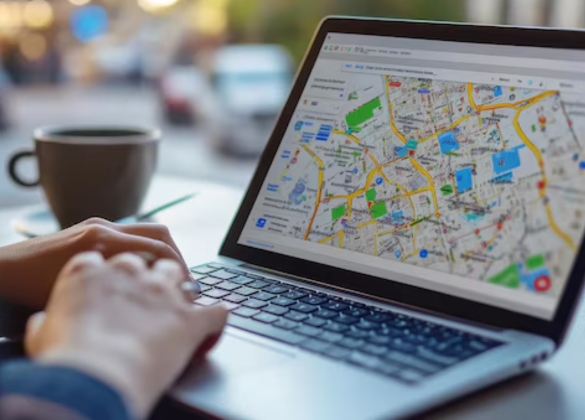Local SEO for Restaurants: A Step-by-Step Checklist
Recently updated: August 4th, 2025
The way customers find restaurants has changed. It’s no longer about being in the right neighborhood; it’s about being in the right search results. Whether someone’s typing “best Thai food near me” or asking their phone “where can I get biryani right now?”, your need Local SEO for Restaurants to be there. This guide walks you through everything you need to do step by step to show up on Google Maps, rank in local searches, and turn digital traffic into real diners.
Local SEO for Restaurants: A Step‑by‑Step Checklist
The rules of restaurant visibility have changed. It’s no longer enough to rely on word-of-mouth, foot traffic, or even traditional SEO. If someone types “best Thai food near me” or “outdoor brunch spots in [City],” and your restaurant doesn’t appear in the map pack or local results, you’re losing business.
Local SEO is now the front door to your restaurant. Whether your customers are searching on Google, Maps, or even asking voice assistants where to grab dinner, this checklist will help your business show up where it matters most.
The restaurants that implement local SEO best practices today won’t just rank higher; they’ll be easier to find, easier to choose, and more likely to turn searches into reservations.
If you manage local seo for restaurant, run a local food business, or want to dominate in “near me” searches, these steps are your starting point.
Step 1: Claim & Optimize Your Google Business Profile (GBP)
Your Google Business Profile is the foundation of local SEO for restaurants. If it’s incomplete, outdated, or inaccurate, every other tactic you try will fall short.
This is the listing that shows up when someone searches for “pizza near me” or “Italian restaurant open now.” It controls how you appear on Google Maps, the local 3-pack, and voice search results, and it can directly impact whether someone visits you or skips past.
Here’s how to make sure your profile works for you, not against you:
-
Claim and Verify Your Listing
Start by finding your restaurant on google.com/business. If no listing exists, create one. If it’s already there, claim it. Then complete the verification process (usually via postcard or phone call) to take full control of the profile.
If you skip this, someone else could suggest edits or mark your listing as closed without you even knowing.
-
Set the Correct Category (and Subcategories)
Google uses your primary category to determine what searches your business appears for. For example:
- “Mexican Restaurant” will help you show up for “tacos near me”
- Restaurant” is too broad and less likely to match local intent
Add relevant secondary categories like “Takeout Restaurant,” “Vegan Restaurant,” or “Family Restaurant” to capture even more queries.
-
Fill Out Every Section of the Profile
The more complete your profile, the better your chances of showing up in search.
Make sure to:
- Add your full Name, Address, and Phone number (NAP) – exactly as it appears on your website and other listings.
- Include a link to your website and menu page.
- Set accurate hours of operation, including special holiday hours.
- List available services: dine-in, delivery, takeout, curbside pickup, etc.
- Choose your service areas (especially for delivery or catering).
-
Upload High-Quality Photos (Regularly)
Restaurants are visual. Customers decide in seconds based on what they see. Add and update:
- Exterior shots (to help users recognize the location)
- Interior seating and ambiance
- Menu items (especially bestsellers or seasonal dishes)
- Team members or chefs at work
- Special events or promotions
Tip: Businesses with more photos typically receive more direction requests and clicks to call.
-
Use Google Posts to Share Updates
 Google Posts let you publish short updates directly to your Business Profile. These can show up in local search results and boost engagement.
Google Posts let you publish short updates directly to your Business Profile. These can show up in local search results and boost engagement.
Post regularly about:
- Weekly specials or new menu items
- Holiday hours or closures
- Live music nights or tasting events
- Customer reviews or testimonials
- Behind-the-scenes kitchen content
These posts expire after 7 days (except for event posts), so keep them fresh and consistent.
Step 2: Local Keyword Research & Long‑Tail “How To” Phrases
If you want your restaurant to appear in searches that actually bring in customers, you need to understand how people are searching and match your content to their exact language.
This is where keyword research for local SEO for restaurant comes in.
People don’t just search “restaurant” anymore. They type (or say):
- “late night Chinese food in Downtown Dubai”
- “best vegan brunch spots near Business Bay”
- “how to book a table at a romantic rooftop restaurant”
These long-tail, highly specific queries are packed with intent and they’re where most local restaurant traffic now lives.
-
Focus on “Near Me” + Cuisine + Location Keywords
Here’s the formula most searches follow:
[Type of food] + [intent or time] + [location or neighborhood]
Examples:
- “seafood lunch near Dubai Marina”
- “family-friendly Italian restaurant in JLT”
- “breakfast cafes open now in Al Barsha”
Use keyword tools like:
- Google Keyword Planner
- Ubersuggest
- Google Trends
- And even Google Autocomplete to find these natural phrases.
Then, use them across your:
- Website copy (homepage, menu pages, landing pages)
- Page titles and meta descriptions
- Blog or FAQ content
- Image alt tags
- Google Business Profile updates
-
Build Content Around “How To” and Conversational Search
Google is becoming more conversational and users are too. Especially with the rise of voice search.
Instead of just “gluten-free pizza,” people ask:
- “Where can I find gluten-free pizza near me?”
- “How to order keto-friendly takeout in [city]?”
- “What’s the best outdoor dining spot in winter?”
You can tap into these by:
- Writing short blog posts or FAQ answers using these exact phrases
- Adding question-based headings (H2s) in your pages
- Including answers to common customer search queries on your homepage or menu page
These long-tail phrases not only help you rank; they also match customer intent more closely, making them more likely to convert.
-
Track Keyword Rankings (But Prioritize Relevance Over Volume)
It’s tempting to chase high-volume keywords, but for local SEO, relevance and intent matter more.
A keyword like “pizza” might have 500K monthly searches, but “wood-fired pizza delivery in [your neighborhood]” may only get 150, yet it could bring in more actual paying customers.
Focus on terms that match:
- What you offer
- Where you operate
- When people need you (e.g., “open now,” “delivery tonight,” “happy hour today”)
Use tools like BrightLocal, Whitespark, or Moz Local to track keyword performance in your geographic area.
Step 3: On‑Page SEO for Local Restaurant Website
Once you’ve identified the right keywords, the next step is making sure your website is built to support them. On-page SEO helps search engines understand your content, match it to user queries, and display your pages in local results.
This is where most restaurants fall short, not because they lack good food or service, but because their website doesn’t speak the language of search.
Here’s how to fix that.
-
Title Tags & Meta Descriptions That Match Local Intent
 Every page on your site needs a unique, keyword-optimized title tag and meta description.
Every page on your site needs a unique, keyword-optimized title tag and meta description.
Title tag examples:
- “Authentic Lebanese Restaurant in Dubai Marina | Al Ahlam Kitchen”
- “Best Rooftop Bar & Tapas in Downtown Dubai”
Meta description tips:
- Keep it under 160 characters
- Include your cuisine, location, and value proposition
- Mention keywords like “reserve now,” “view menu,” or “delivery available”
These appear directly in search results and heavily influence click-through rates.
-
Heading Tags (H1, H2) and Clear Content Structure
Your website should follow a clean hierarchy using heading tags. Use your primary keyword in the H1, and related phrases in H2s and H3s.
For example:
- H1: “Authentic Thai Cuisine in Jumeirah”
- H2: “Our Lunch & Dinner Menu”
- H2: “Why Locals Love Our Pad Thai”
- H2: “How to Reserve a Table at Our Restaurant”
Search engines scan headings to understand page content, use them to guide both bots and users.
-
Image SEO: Alt Text That Describes What’s on the Plate
Images can help or hurt SEO depending on how they’re handled. Avoid filenames like IMG_1083.jpg and generic alt text like “food photo.”
Instead, describe exactly what’s shown:
- Alt text: “Spicy chicken biryani served in clay pot at Dubai Creek restaurant”
- Alt text: “Outdoor seating area with sunset view at Indian fine dining in New York”
Search engines (and visually impaired users) rely on this to understand images, so don’t leave it blank.
-
Embed Google Maps and Write Out Your Address
Your Contact or Visit Us page should include:
- An embedded Google Map of your location
- Full written address in text (not just in an image or footer)
- Click-to-call phone number
- Link to get directions
This helps Google match your website to your Google Business Profile and reinforces local relevance.
-
Keep NAP Consistent Across All Pages
Your Name, Address, and Phone number should appear exactly the same across your entire site – spacing, spelling, abbreviations, everything.
- Don’t write “St.” in one place and “Street” in another.
- Don’t switch between “+971-50-1234567” and “050 123 4567.”
This consistency helps with local rankings and avoids confusing Google.
-
Add LocalBusiness Schema Markup
Schema is a type of code that tells search engines more about your business in a structured format. For restaurants, this is especially useful.
Use LocalBusiness or Restaurant schema to include:
- Business name
- Cuisine type
- Address
- Phone number
- Hours
- Menu link
- Price range
- Reservation URL
Tools like Google’s Structured Data Markup Helper or plugins like Yoast SEO/Rank Math (for WordPress) can help you implement it correctly.
Step 4: Online Reviews & Reputation Management
For restaurants, reviews don’t just build trust; they drive rankings.
Google explicitly states that review quantity, quality, and frequency influence local search visibility. But more importantly, potential customers read reviews before deciding where to eat. A few recent, detailed reviews can make the difference between a full dining room and an empty one.
Here’s how to build a review strategy that supports your local SEO goals and boosts real-world results.
-
Encourage Customers to Leave Reviews
The best time to ask for a review is when a guest leaves happy.
Ways to request reviews:
- Include a QR code on table cards or receipts linking to your Google page
- Send a follow-up message after delivery or online orders
- Ask verbally after a positive in-person experience
- Offer a small incentive (e.g. free dessert on next visit) if it’s allowed by platform policies
Important: Never fake reviews or offer direct compensation. Google can detect review manipulation and penalize it.
-
Prioritize Google, But Don’t Ignore Other Platforms
While Google reviews carry the most weight for local SEO, potential customers also check:
- TripAdvisor (especially for tourist-heavy areas)
- Zomato, Yelp, or Facebook
- Niche sites like HappyCow (for vegan/vegetarian options) or TheFork
Set up and monitor all relevant profiles. The more positive signals Google sees across platforms, the better your authority.
-
Respond to Reviews, Even the Negative Ones
 Every review is a chance to show you care.
Every review is a chance to show you care.
Respond to all reviews with:
- A thank you for the feedback
- Personal touches (mention the dish they ordered or the staff member they praised)
- A clear, calm approach to any issues raised
For negative reviews:
- Acknowledge the problem
- Avoid getting defensive
- Offer to make things right privately
A well-handled negative review can impress potential customers more than a generic 5-star one.
-
Monitor Review Metrics: Volume, Recency, and Ratings
Consistency matters more than perfection.
Aim for:
- A steady flow of new reviews (at least a few per month)
- Responses within 48–72 hours
- An average rating of 4.2 or higher
Use tools like Google Business dashboard, Whitespark, or ReviewTrackers to monitor trends and respond from one place.
Step 5: Local Citations & Directory Listings
Think of citations as digital mentions of your restaurant across the web. When your business is consistently listed (with the same name, address, and phone number) across trusted platforms, it sends strong local authority signals to Google.
This doesn’t just improve your visibility in search; it also builds trust with potential customers who discover you through these platforms.
Here’s how to get your citations right.
-
Get Listed on Top Restaurant and Local Directories
Start with the most influential directories for local SEO:
- Google Business Profile (it’s #1)
- TripAdvisor
- Zomato
- Yelp
- Bing Places
- Apple Maps
- Foursquare
- City-focused directories
Tip: Make a spreadsheet to track all directories, login details, and listing status.
-
Ensure NAP Consistency Across All Listings
Your Name, Address, and Phone Number must be exactly the same on every platform.
For example, these are seen as different by search engines:
- “Al Ahlam Kitchen, Jumeirah St.”
- “Al-Ahlam Kitchen – Jumeirah Street”
Use a single, consistent format, including punctuation, abbreviations, and spacing – everywhere your restaurant appears.
-
Fill Out Profiles Completely
Don’t just claim the listing and leave it blank. Take the time to:
- Add your website, menu link, and reservation URL
- Upload high-resolution images
- Select the right cuisine category
- List hours, parking availability, delivery zones, etc.
The more complete your listings, the more signals you send to Google (and the more helpful you are to customers).
-
Monitor and Remove Duplicates
Duplicate listings can confuse both search engines and customers.
Use tools like:
- Moz Local
- BrightLocal
- Yext (for larger chains)
…to scan for and remove duplicate or outdated listings that may hurt your rankings or cause incorrect info to surface.
Pro tip: Set a quarterly reminder to audit your citations and fix inconsistencies.
Step 6: Local Link Building & Community Signals
Links are still one of the strongest ranking factors in SEO, but not all links are equal. For restaurants, local links matter more than global ones.
The goal here isn’t to chase high domain authority, it’s to build real connections in your local area that signal to Google (and customers) that you’re an active part of the community.
Here’s how to do that in a way that boosts both SEO and foot traffic.
-
Partner with Local Food Bloggers and Influencers
Local food bloggers are often trusted voices in the community and their websites rank well in Google.
Ways to collaborate:
- Invite them for a free tasting or soft launch
- Offer a behind-the-scenes kitchen tour
- Run joint giveaways or contests on Instagram
- Ask if they’d be open to reviewing your restaurant on their blog or tagging your location on social platforms
These links and mentions help build natural authority and also drive direct traffic.
-
Sponsor Community Events or Initiatives
 Even a small event sponsorship can lead to:
Even a small event sponsorship can lead to:
- A mention on the event website (with a backlink)
- Logo placement and NAP citation
- Shoutouts on social media or in local press
Look out for:
- Food festivals
- Local farmer’s markets
- School or sports team sponsorships
- Cultural events in your neighborhood
-
Get Featured in Local News or Lifestyle Sites
Reach out to local magazines, online publications, and community blogs with:
- Press releases about a new menu or location
- Feature pitches (“Top 5 rooftop cafes in [City]”)
- Human-interest stories (chef spotlights, sustainability efforts, etc.)
Even a small feature with a link can boost your site’s local trust signals.
-
Join Local Business Associations and Restaurant Groups
Chambers of commerce and hospitality associations often list their members on their websites.
- These are usually high-authority domains
- You’ll get a trustworthy backlink and citation
- It opens the door for networking and collaborations
-
Link Internally Across Your Own Content
Internal linking is often overlooked.
If you write a blog post about “Hosting Corporate Lunches at Our Downtown Location,” link it to your:
- Contact or reservation page
- Menu page
- Location landing page
This creates a web of connections within your site, making it easier for both users and search engines to navigate.
Step 7: Create Localized, Helpful Content
Content isn’t just for blogs or social media; it’s a key driver of local search visibility. If your restaurant’s website only lists the menu and contact info, you’re missing a huge opportunity to attract searchers looking for specific dining experiences.
Great local content helps you:
- Appear in long-tail searches like “best gluten-free breakfast in JLT”
- Build trust with first-time visitors
- Show Google that you’re relevant to your community
Here’s how to create content that ranks and resonates.
-
Write About Local Food Topics People Are Searching For
Think like your customers. What would they type into Google before finding you?
Examples:
- “Where to find late-night biryani in Dubai Marina”
- “Top vegan restaurants in Downtown Dubai”
- “Romantic dinner spots with outdoor seating in Jumeirah”
Create short blog posts or landing pages targeting these queries. Include real details (dishes, hours, ambience, location info) to make the content useful, not just keyword-stuffed.
-
Add “How-To” Style Content That Matches Voice Searches
With more people using voice assistants to find restaurants, questions are getting more conversational.
You can rank for queries like:
- “How to reserve a table for 10 at a rooftop restaurant”
- “What’s the best place for a business lunch near DIFC?”
- “How to order gluten-free pizza in Dubai online?”
Add FAQs or quick guides on your website answering these questions. Use schema markup to help Google feature them as rich snippets.
-
Share Stories, Events, and Behind-the-Scenes Updates
People love knowing the face behind the food.
Content ideas:
- A short post introducing your head chef and their background
- A photo tour of your kitchen or how a signature dish is prepared
- Recaps of events, tastings, or pop-ups you’ve hosted
- Community stories, like local collaborations or charity drives
This builds emotional connection and encourages repeat visits, both online and in person.
-
Create Pages for Each Location (If You Have Multiple Branches)
If you operate in more than one area, don’t list everything on one page.
Instead:
- Create a separate page for each location
- Include location-specific keywords, hours, photos, and directions
- Link each page to your Google Business Profile for that branch
This helps each location rank independently in its area.
Step 8: Technical SEO & Mobile‑First Optimization
You could have the best food and a beautifully designed site, but if it loads slowly, breaks on mobile, or confuses search engines, you’re out of the game.
Technical SEO ensures that your restaurant website is fast, accessible, and easy to understand for both users and Google.
Here’s how to check and fix the key technical elements that impact your local visibility.
-
Make Your Website Mobile‑Friendly
 More than 70% of local restaurant searches happen on mobile devices. If your site isn’t easy to navigate on a phone, you’re losing reservations and deliveries by the minute.
More than 70% of local restaurant searches happen on mobile devices. If your site isn’t easy to navigate on a phone, you’re losing reservations and deliveries by the minute.
Ensure that:
- Pages load quickly (under 3 seconds is ideal)
- Buttons are large enough to tap without zooming
- Menus are readable without pinching or horizontal scrolling
- Click-to-call and click-to-map functions work smoothly
Use Google’s Mobile-Friendly Test to see where you stand.
Tip: Avoid PDF menus, they’re hard to read and nearly impossible to optimize for search.
-
Speed Up Your Load Time
Google considers site speed a ranking factor and users won’t wait for a slow site.
Improve performance by:
- Compressing images (especially large food photos)
- Using lazy loading for off-screen images
- Minimizing unnecessary plugins or scripts
- Leveraging browser caching
Tools like PageSpeed Insights or GTmetrix can help identify what’s slowing you down.
-
Secure Your Site with HTTPS
A secure website builds trust. If your site still starts with http://, install an SSL certificate and upgrade to https://.
Search engines prioritize secure sites, and browsers now label unsecured ones as “Not Secure” – a red flag for customers.
-
Use Clean URL Structures
URLs should be simple and readable, both for users and search engines.
Bad example:
www.yourrestaurant.com/page?id=23&menu=234
Better example:
www.yourrestaurant.com/menu/lunch-specials
Stick to lowercase letters, hyphens instead of underscores, and include target keywords when relevant.
-
Set Up Google Analytics and Search Console
These tools let you monitor how users find and interact with your site and catch indexing or technical issues before they hurt your rankings.
With Google Analytics, track:
- Pageviews
- Bounce rates
- Mobile usage
- Goal conversions (e.g., reservation clicks or menu views)
With Google Search Console, you can:
- Monitor index coverage
- Submit your sitemap
- Check crawl errors or mobile usability issues
- Track keyword performance and click-through rates
Think of these as your restaurant’s digital CCTV, quietly monitoring what’s working and what’s broken.
Step 9: Advanced Tactics for Voice Search & “Near Me” Queries
As more people rely on voice assistants like Siri, Alexa, and Google Assistant to find restaurants, your local SEO for restaurant strategy needs to speak their language.
Voice search is changing how people discover food nearby. Instead of typing “tandoori chicken restaurant,” users are now saying:
- “Hey Google, where can I get spicy tandoori chicken near me right now?”
- “What’s the best seafood place open late in [neighborhood]?”
These longer, more conversational queries require you to optimize differently. Here’s how to do it right.
-
Optimize for Conversational, Question-Based Phrases
Voice search is natural language.
That means your content should mirror how people actually speak. Use headings like:
- “Where can I eat gluten-free in [location]?”
- “What time does our restaurant open on weekends?”
- “How to reserve a table for a large group in [City]”
Then, answer each question directly below the heading in clear, concise language. Google pulls featured snippets and voice answers from pages that provide straightforward responses.
Tip: Use FAQ sections on your homepage, location pages, or even your menu pages.
-
Add FAQ Schema to Eligible Pages
By marking up your FAQs with structured data (schema.org), you increase your chances of being featured in voice search and Google’s rich results.
Make sure your FAQs cover:
- Hours and reservations
- Dietary options (vegan, halal, gluten-free)
- Parking or delivery availability
- Popular dishes or chef’s recommendations
Use tools like Merkle’s Schema Markup Generator or plugins like Rank Math (WordPress) to implement it without code.
-
Target “Open Now” and Time-Based Searches
 Many voice searches are urgent.
Many voice searches are urgent.
Think:
- “What’s open for lunch right now near me?”
- “Best place to eat after midnight in [location]”
To rank for these:
- Keep your Google Business Profile hours updated (including holidays)
- Add phrases like “open late,” “lunch specials,” or “serves breakfast daily” in your page copy
- Use time-sensitive keywords in meta descriptions and Google Posts
Pro tip: Enable messaging or reservation buttons so voice users can take immediate action.
-
Claim “Near Me” Rankings with Proximity-Based Pages
Even though you can’t technically optimize for “near me,” you can improve your chances by:
- Embedding a Google Map on your pages
- Writing detailed directions using nearby landmarks
- Adding location modifiers in page titles and H1 tags
(e.g. “Thai Street Food in Downtown Dubai Near the Creek”)
Google uses geographic signals to match voice queries to businesses. Make it crystal clear where you are.
Step 10: Track, Monitor & Update (Weekly to Monthly)
Local SEO isn’t a one-time setup; it’s a living system that needs ongoing attention. Think of it like your restaurant’s front-of-house: clean it up, restock, and refresh the presentation regularly.
If you want to stay visible in “near me” searches and keep up with local competitors, you’ll need to track performance and make updates part of your routine.
Here’s how to manage it without turning it into a full-time job.
Weekly: Keep Your Google Business Profile Fresh
Consistency is key.
Set aside 15–20 minutes each week to:
- Add new photos (especially of bestsellers or weekend specials)
- Post updates or offers via Google Posts
- Respond to all new reviews – good or bad
- Check for suggested edits (Google may auto-update info based on user input)
A steady trickle of activity shows Google your business is active and trustworthy.
Monthly: Review Website and SEO Performance
Use your Google Analytics and Search Console to understand:
- How people are finding you (keywords, locations, devices)
- Which pages are getting traffic, and which aren’t
- What content leads to bookings or clicks to call
Then update:
- Page content with underperforming keywords
- Outdated hours, menu items, or offers
- Broken links or images that slow down your site
Quarterly: Audit Your Citations and Listings
Scan major directories to ensure your NAP info is still accurate.
- Look for duplicate or outdated listings
- Update photos, menus, or service options
- Reclaim access to profiles if staff members who managed them have left
Tools like Moz Local or BrightLocal can speed this up by scanning multiple sites at once.
Ongoing: Watch Your Competitors
If a nearby restaurant suddenly climbs the ranks, dig into why:
- Are they getting more reviews?
- Did they launch a new page or offer?
- Are they running a local PR campaign?
Use tools like Whitespark or simply observe Google Maps rankings over time.
What works for them might inspire improvements in your own strategy without copying.
Conclusion
Showing up in local search isn’t just about algorithms; it’s about being seen by real people who are hungry, nearby, and ready to take action. If local SEO for restaurants isn’t part of your strategy, you’re leaving visibility, bookings, and revenue on the table. But with this checklist, you’re not just playing catch-up, you’re setting the table for long-term, compounding results.
The search for good food starts online. With the right local SEO strategy, your restaurant won’t just show up, it’ll stand out.
Frequently Asked Questions
What is local SEO for restaurants?
Local SEO is the process of optimizing your restaurant’s online presence to show up in local search results, especially on Google Maps, “near me” searches, and mobile queries. It helps nearby customers find your business when they’re searching for places to eat.
How do I get my restaurant on Google Maps?
You’ll need to claim and verify your restaurant on Google Business Profile. Once verified, you can add your address, phone number, photos, menu, and hours so your business appears on Google Maps and local search listings.
Why are reviews important for restaurant SEO?
Reviews signal trust to both search engines and customers. Google uses review quantity, quality, and frequency as local ranking factors. More importantly, positive reviews influence customer decisions and can directly drive more bookings or visits.
How can I rank higher for “near me” restaurant searches?
To appear in “near me” searches, you need to:
- Optimize your Google Business Profile
- Use location-based keywords on your website
- Ensure consistent NAP info across all platforms
- Get local backlinks and reviews
- Add schema markup to your site
- Create content targeting voice search and specific neighborhoods
How often should I update my Google Business Profile?
Ideally, update your profile weekly. Add fresh photos, share events or offers using Google Posts, and respond to all reviews promptly. An active profile shows Google and potential customers that your business is reliable and engaged.
Should I create separate pages for each restaurant location?
Yes. If your restaurant has multiple branches, create a dedicated landing page for each one. Include the address, contact details, hours, photos, and menu specific to that location. This helps each branch rank for local searches in its own area.
What’s the best way to get backlinks for a restaurant website?
Focus on local relevance. Reach out to food bloggers, sponsor community events, collaborate with nearby businesses, or pitch stories to local news outlets. Even one or two high-quality local links can improve your visibility more than dozens of irrelevant ones.
Can I do local SEO without a website?
Technically yes, but it’s not ideal. While a well-optimized Google Business Profile can get you some visibility, having a dedicated website strengthens your authority, allows more control over content, and helps you show up in a wider range of local searches.
What kind of content should a restaurant publish?
Start with location-based blogs, FAQs, event updates, and “best of” lists. Highlight signature dishes, staff stories, behind-the-scenes prep, and dining experiences. Focus on content that answers questions customers are actually searching for.
How long does it take to see results from local SEO?
Some results (like Google Business Profile updates) can show within days. Others, like improved rankings or more traffic from citations and content, typically take 1–3 months. Local SEO is a cumulative effort, so consistency is key.
Latest posts by Vijaya Tyagi (see all)
AI Mentions Are the New Backlinks – Why They Matter - December 10, 2025
Local AI SEO: Get Picked for “Near Me” - November 26, 2025



